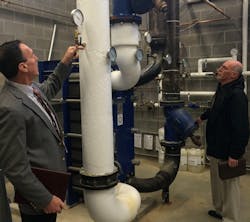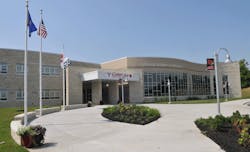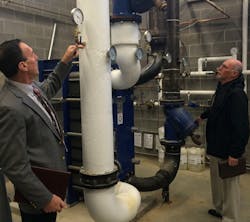Hybrid design powers Kentucky high school’s mechanical system
WINCHESTER, KY. — Chilled beams with a splash of DOAS. Sounds like a stiff drink on a hot summer’s night. But sustainable HVAC design is the straw that stirs the drink at the new $60-million, 300,000-sq.ft. George Rogers Clark High School in Winchester, Ky. The design is helping record up to 70% less monthly utility costs over the typical HVAC design while providing better indoor air quality and comfort than the 30% smaller conventional building it replaced.
“The key number here is 33.7, as in kBtu/square foot/year (based on the preliminary analysis, approximately 16.3 is due to total heating and cooling of the facility, and 17.4 kBtu/square foot/year is due to lighting and plug load),” said Mark Saunier, B.S.E.E., LEED AP, CEM and president of energy company, Comfort & Process Solutions (CPS). “Compared to schools nationwide that average nearly 68 kBtu/sq. ft./yr, George Rogers Clark High School’s Energy Use Intensity (EUI) is significantly lower.”
Yet even more incredible regarding the school’s EUI, George Rogers Clark High School also is host to the area technology center, the state-of-the-art vocational wing serving the Clark County community, which calls for even more energy. And, high schools typically use more energy than middle schools or elementary schools.
One reason for the increased efficiency is a hybrid HVAC design, featuring a geothermal well field that supplies active chilled beams, dual wheel outdoor air dehumidification systems for a dedicated outdoor air system (DOAS), according to Paul Christy, superintendent, Clark County Public Schools.
Originally specified as a conventional 200-ft., 80-well geothermal field with just ground source heat pumps (GSHPs), Christy was adamant in replacing the proposed 350 heat pumps with 542 active chilled beams and six SEMCO Pinnacle Series DOAS heat recovery systems.
Christy’s decision was based on visiting a similar system at Furman University and reviewing a building energy simulation report prepared by SEMCO. The report compared the estimated annual energy consumption of the high school’s three most-likely HVAC approaches:
• A DX-based outdoor air system, including a total energy recovery wheel and hot gas reheat capabilities preconditioning the outdoor air delivered directly to the classroom spaces served by individual GSHPs.
• A DOAS incorporating both energy recovery and passive dehumidification wheels, served by a ground source heat pump to precondition outdoor air delivered directly to the classroom spaces served by individual GSHPs.
• A DOAS and active chilled beams combination all served by a GSHP chiller to condition the media center and all classrooms.
Efficiency equals savings
Ultimately, some of the greatest efficiency is attributed to a 50% air flow reduction that chilled beam technology offers versus conventional forced air distribution methods.
The old school building from the 1960s had a four-pipe boiler/chiller system with fan coil units, and was averaging annual utility costs of approximately $194,040 ($.97/sq. ft.).
Construction started in November 2010 and finished in April 2013, and the new high school was student-ready by August 2013. “In the first four months of operation, the new building’s preliminary utility bill figures were $41,800 less than our old building during the same period,” said Christy.
More than 300 contractors attend ClimateMaster’s GeoFarm Field Training
ClimateMaster’s Trilogy 40 Receives Federal Laboratory Consortium Award
“The mechanical system was installed for $19.50 per sq. ft., which is the same or less than water source heat pumps or VRV ground source systems currently in Kentucky,” said Saunier.
The savings comes primarily from better humidity control and subsequently higher set point temperatures with no trade-off of indoor air comfort. The system’s comparably lower 43°F dew point temperature allows for greatly reduced air volume due to the humidity control from dual-wheel dehumidifiers that control both latent and sensible humidity, according to Saunier, who helped convert the original design from conventional heat pumps to Christy’s requested chilled beam concept.
“With this system, outdoor air requirements are easily met, providing more comfort, lower levels of humidity, fresher air and better indoor air quality,” said Tom McCullough, senior project manager, Davis & Plomin, the installing mechanical and sheet metal contractor on the project.
The SEMCO IQHC chilled beams, which are supplied by a water-to-water ClimateMaster Tranquility series GSHPs, have a 12-slot nozzle that is field-adjustable for areas with excessive solar gain or heat loss.
“Located in mechanical pods, the ground source heat pumps source the heating and cooling,” said McCullough.
The school’s service department is training the high school maintenance staff to adjust volume and up to a 45-degree angle directional airflow for hotspots with each chilled beam’s hand-operated levers for the greatest airflow flexibility efficiency.
The chilled beams never develop condensation because five rooftop DOAS units ranging from 3,700 to 14,500-cfm supply them with semi-neutral, super dry air. There is one 7,000-cfm DOAS that resides in a mechanical room. Some areas with high ceilings that aren’t ideal for chilled beams, such as the cafeteria and gym, use their own DOAS to distribute cooling and heating via the GSHP loop.
The DOAS units feature VFD, integrated GSHPs, and dew point discharge control that are all interfaced with the school’s building automation system by Delta Controls. The control system runs through each DOAS unit’s wintertime supply temperature control stages that use the enthalpy wheels’ heat recovery to minimize the onboard mechanical heat pump’s runtimes.
The system also saves energy by maintaining humidity with a recirculation mode during unoccupied periods, which lessens ramp up time heating or cooling when the school opens each day.
Christy witnessed an increase in student attendance in the first five months of operation in the 2013 fall semester versus the same period the previous year. This increase of student attendance in the high school generated approximately $59,000 in additional funds for the district. He attributed this partially to the IAQ and humidity control.
“Because of space restrictions in a retrofit, we see chilled beams as space-saving and an air comfort solution,” said Christy.
In addition to energy savings, the project boasted:
• Proper ventilation provided to the spaces all the time; improved IAQ translates to reduced absenteeism.
• Ideal humidity control provided all the time.
• Substantially less filter maintenance (labor) — one source at each Pinnacle and not at each classroom. Few schools have the maintenance staff to change filters in each classroom every 60 days as called for by the majors for conventional systems.
• Less space used with the mechanical system compared to other water source heat pump projects.
• No condensate management control system or issues.
• No fans to maintain within the classroom space.
• Low sound levels for teachers so they can be heard loud and clear.


